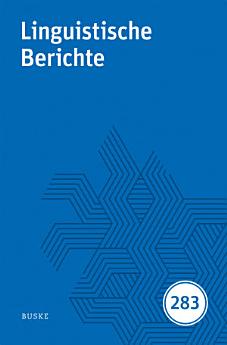Linguistische Berichte Heft 283
Markus Steinbach · Nina-Kristin Meister · Günther Grewendorf · Arnim von Stechow
2025 සැප් · Helmut Buske Verlag
ඉ-පොත
144
පිටු
family_home
සුදුසුකම් ලබයි
info
reportඇගයීම් සහ සමාලෝචන සත්යාපනය කර නැත වැඩිදුර දැන ගන්න
මෙම ඉ-පොත ගැන
Vorwort – Felicitas Otte, Markus Steinbach & Nina-Kristin Meister: Auf dem Weg zur digitalen Barrierefreiheit in den Linguistischen Berichten: Errungenschaften und Ziele Aktuelle Tendenzen in der Linguistik – Silva H. Ladewig: Aktuelle Trends und Entwicklungen in der linguistischen Gesten- und Multimodalitätsforschung Abstract: In the late 20th century, gestures were mainly regarded as part of pragmatics, separate from core linguistic fields like phonetics, morphology, syntax, and semantics. This division was rooted in Chomsky's (1965) distinction between linguistic competence and performance, with only the former being considered within the scope of linguistics. This paper demonstrates that gestures have now become central to core linguistic research. It examines recent developments in gesture and multimodality research within linguistics, beginning with a discussion of gesture concepts, followed by an introduction to gestures as an empirical phenomenon. Recent find-ings on gestural modality and its integration into spoken language are presented, highlighting three key themes: the role of gestures in emphasizing information, their integration into syntax and prosody, and the emergence and stabilization of gestural and multimodal patterns. These developments suggest a growing recognition of gesture as integral to linguistic study. Beiträge aus Forschung und Anwendung – Sebastian Walter: Investigations on the at-issue status of viewpoint gestures Abstract: Most accounts of the semantic contribution of 'co-speech gestures' posit that they contribute 'not-at-issue' meaning by default (e. g., Ebert & Ebert 2014). This claim has been experimentally validated by Ebert, Ebert & Hörnig (2020) for gestures conveying information about an ob-ject's size or shape. In this article, the findings from two rating studies are reported investigat-ing the at-issue status of 'character' and 'observer viewpoint gestures' (CVGs and OVGs, respectively, McNeill 1992). It is questionable whether the findings of Ebert, Ebert & Hörnig's (2020) study hold equally strong for CVGs and OVGs, as especially the former gesture type differs in size from the gestures used in their study. The results of the studies suggest that while both gesture types contribute not-at-issue meaning by default, CVGs can shift more toward the at-issue dimension than OVGs if they provide information relevant to the 'question under discussion', in line with a gradient approach to at-issueness (Barnes & Ebert 2023). – Winfried Thielmann: Tempus und Zeit: Phänomene – Konzepte – linguistische Kategorienbildung Abstract: It is widely held that temporal morphemes refer to temporal structures of reality in the way presented by Reichenbach in his 'Symbolic Logic' (1947). One of the earliest elaborations of the concept of time, namely the one found in Aristotle's 'Physics', however, suggests that time is not a property of nature, but a complex linguistic elaboration of the human mind in order to come to terms with nature: Counting deictic focusing acts with respect to repeated constellations of a reference movement, e. g., meridian transits of the sun, the human psyche establishes a reference space that has no reality outside the human psyche. Because of this it is argued that it is quite implausible that grammatical morphemes should express a complex notion that relies on things such as number and a numeral system, but, rather, that it is later reifications of the concept of time gave rise to the assumption that linguistic structures encode temporal logic. As it will be shown, 'temporal' morphemes of German can indeed be described without reference to time, as they have a much more basic meaning. Hence it may be meaningful to ask the question, if linguistic thinking might in general be misled in believing that complex categories such as 'time' or, for instance, 'causality', are encoded in grammatical structures.
කර්තෘ පිළිබඳ
Nina-Kristin Meister (geborene Pendzich) hat an der Georg-August-Universität Göttingen Deutsche Philologie und Geschichte studiert und in Germanistischer Linguistik zum Thema »Lexikalische nichtmanuelle Markierungen in der Deutschen Gebärdensprache (DGS)« promoviert. Seit 2017 ist sie Leiterin des Experimentellen Gebärdensprachlabors am Seminar für Deutsche Philologie der Georg-August-Universität Göttingen und unterrichtet Germanistische Linguistik mit Schwerpunkt in der DGS. Ebenfalls seit 2017 ist sie in der Redaktion der Fachzeitschrift »Linguistische Berichte« tätig.
මෙම ඉ-පොත අගයන්න
ඔබ සිතන දෙය අපට කියන්න.
කියවීමේ තොරතුරු
ස්මාර්ට් දුරකථන සහ ටැබ්ලට්
Android සහ iPad/iPhone සඳහා Google Play පොත් යෙදුම ස්ථාපනය කරන්න. එය ඔබේ ගිණුම සමඟ ස්වයංක්රීයව සමමුහුර්ත කරන අතර ඔබට ඕනෑම තැනක සිට සබැඳිව හෝ නොබැඳිව කියවීමට ඉඩ සලසයි.
ලැප්ටොප් සහ පරිගණක
ඔබට ඔබේ පරිගණකයේ වෙබ් බ්රව්සරය භාවිතයෙන් Google Play මත මිලදී ගත් ශ්රව්යපොත්වලට සවන් දිය හැක.
eReaders සහ වෙනත් උපාංග
Kobo eReaders වැනි e-ink උපාංග පිළිබඳ කියවීමට, ඔබ විසින් ගොනුවක් බාගෙන ඔබේ උපාංගයට එය මාරු කිරීම සිදු කළ යුතු වේ. ආධාරකරු ඉ-කියවනයට ගොනු මාරු කිරීමට විස්තරාත්මක උදවු මධ්යස්ථාන උපදෙස් අනුගමනය කරන්න.








